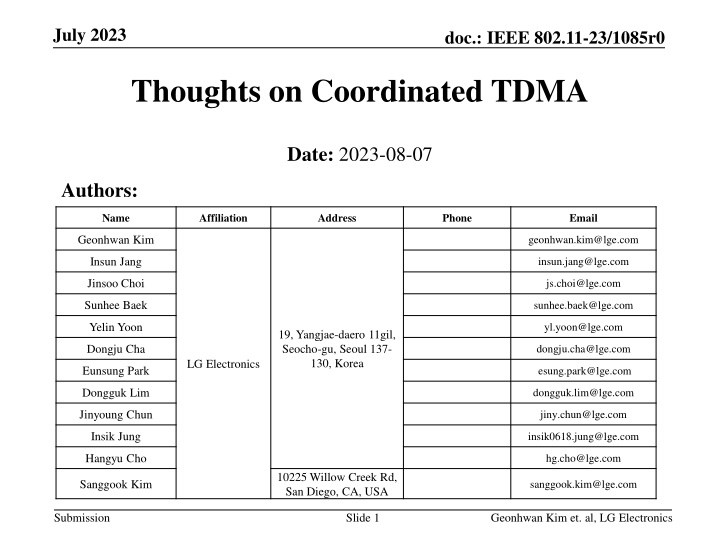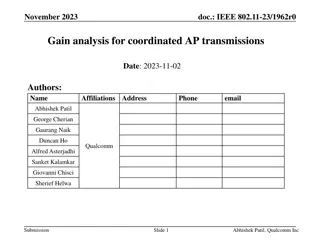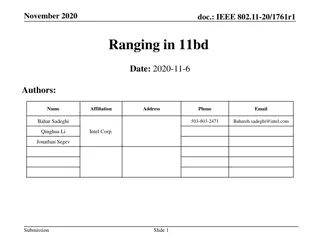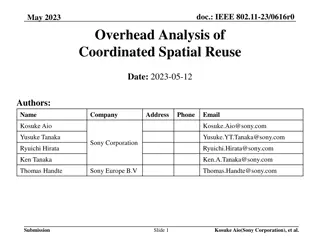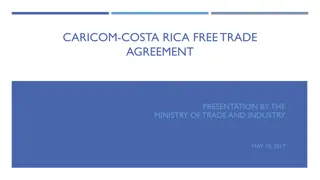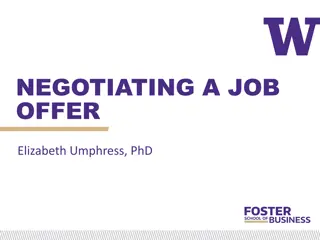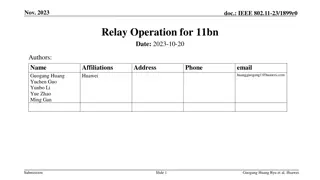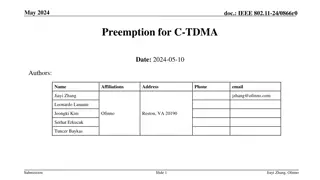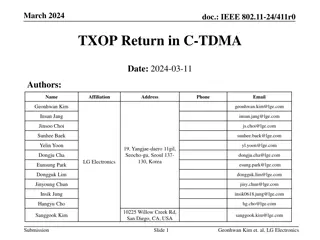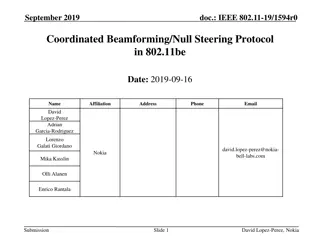Coordinated TDMA Protocol in UHR: Negotiation & Agreement
Multi-AP coordination schemes, especially Coordinated TDMA (C-TDMA), play a crucial role in achieving efficient communication. This document discusses the protocol for negotiation and agreement among APs participating in C-TDMA in the UHR spectrum.
Download Presentation

Please find below an Image/Link to download the presentation.
The content on the website is provided AS IS for your information and personal use only. It may not be sold, licensed, or shared on other websites without obtaining consent from the author.If you encounter any issues during the download, it is possible that the publisher has removed the file from their server.
You are allowed to download the files provided on this website for personal or commercial use, subject to the condition that they are used lawfully. All files are the property of their respective owners.
The content on the website is provided AS IS for your information and personal use only. It may not be sold, licensed, or shared on other websites without obtaining consent from the author.
E N D
Presentation Transcript
July 2023 doc.: IEEE 802.11-23/1085r0 Thoughts on Coordinated TDMA Date: 2023-08-07 Authors: Name Affiliation Address Phone Email Geonhwan Kim geonhwan.kim@lge.com Insun Jang insun.jang@lge.com Jinsoo Choi js.choi@lge.com Sunhee Baek sunhee.baek@lge.com Yelin Yoon yl.yoon@lge.com 19, Yangjae-daero 11gil, Seocho-gu, Seoul 137- 130, Korea Dongju Cha dongju.cha@lge.com LG Electronics Eunsung Park esung.park@lge.com Dongguk Lim dongguk.lim@lge.com Jinyoung Chun jiny.chun@lge.com Insik Jung insik0618.jung@lge.com Hangyu Cho hg.cho@lge.com 10225 Willow Creek Rd, San Diego, CA, USA Sanggook Kim sanggook.kim@lge.com Submission Slide 1 Geonhwan Kim et. al, LG Electronics
July 2023 doc.: IEEE 802.11-23/1085r0 Introduction Multi-AP coordination schemes can be categorized as follows [1]: by dividing the time (Coordinated TDMA), by splitting the spectrum (Coordinated OFDMA), by coordinating the spatial resource (Coordinated SR), by limiting interference from other APs (Coordinated Beamforming/Nulling), etc. Among these schemes, Coordinated TDMA (C-TDMA) can be designed based on the Triggered TXOP Sharing (TXS) in EHT. Therefore, there are advantages in terms of simple design and protection. Some contributions [2]-[4] to C-TDMA that extend/utilize existing Triggered TXS were presented. In this contribution, we share some considerations to achieve an C-TDMA as one candidate feature of M-AP coordination in UHR. Especially in terms of negotiation, protection, and support for multiple shared APs. Submission Slide 2 Geonhwan Kim et. al, LG Electronics
July 2023 doc.: IEEE 802.11-23/1085r0 Re-cap: Triggered TXOP Sharing AP allocates the time of the obtained TXOP to support non-TB PPDU and P2P transmission to the non-AP STA. If the TXOP Sharing Mode subfield in the User Info field has a nonzero value, MU-RTS Trigger Frame (TF) is called MU-RTS TXS TF. TXOP Sharing mode = 1; One or more non-TB PPDUs can be sent to AP. TXOP Sharing mode = 2; In addition to non-TB PPDUs transmission to the AP, it also supports P2P transmission. Currently, TXS uses SCS procedure/A-Control (being discussed) to negotiate the required TXOP duration. Furthermore, the details of the frame exchange between the time- allocated STA (P2P TX) and the P2P RX are not covered in the 11be spec. To utilize TXS in M-AP coordination, the following can be considered: Negotiation between APs can results in different TXOP sharing scenarios. Also, depending on the scenarios, NAV issues may exist on non-AP STAs associated with shared AP. Submission Slide 3 Geonhwan Kim et. al, LG Electronics
July 2023 doc.: IEEE 802.11-23/1085r0 Coordinated TDMA Protocol in UHR AP that has obtained the TXOP can exchanges frames within its BSS. A sharing AP (TXOP holder) may allocates the time to the shared AP with a MU- RTS TXS TF (or Ctrl frame). The shared AP may also transmits data to the STAs in the BSS 2 for an allocated time. For the remaining TXOP after the time allocated to the shared AP, the sharing AP may resumes frame exchange in its BSS. Submission Slide 4 Geonhwan Kim et. al, LG Electronics
July 2023 doc.: IEEE 802.11-23/1085r0 Negotiation & Agreement (1/2) APs participating in C-TDMA need to collect and negotiate information for smooth cooperation in the time domain. These APs may negotiate the following information: Operating channel & bandwidth Required TXOP duration Low Latency Traffic Information Basically, the AP that wins the contention first becomes the sharing AP. Based on the negotiation, the sharing AP will be able to decide when to share TXOP to the shared AP. In addition, the C-TDMA procedure may vary depending on the TXOP sharing scenario (see next slide for details). Submission Slide 5 Geonhwan Kim et. al, LG Electronics
July 2023 doc.: IEEE 802.11-23/1085r0 Negotiation & Agreement (2/2) Examples of TXOP Sharing Scenario It may be necessary to negotiate/agree in advance when (or whether) to share TXOP among participating APs based on the negotiation information. Submission Slide 6 Geonhwan Kim et. al, LG Electronics
July 2023 doc.: IEEE 802.11-23/1085r0 Protection (1/2) Protection methods should be designed carefully in C-TDMA. In a TXOP initiated by the sharing AP, the NAV is set to prevent the non-AP STAs associated with sharing AP and (neighboring) shared AP(s) from competing for the channel. Shared AP and non-AP STAs associated with shared AP can set Basic NAV as follows: MU-RTS TXS Trigger frame sent by sharing AP and(or) CTS frame sent by shared AP Frames sent by non-AP STAs associated with sharing AP After sending the CTS frame solicited by an MU-RTS TXS TF from the sharing AP, the shared AP can ignore the NAV that is set by the sharing AP. However, since non-AP STAs cannot ignore the basic NAV, they cannot transmit UL data to the shared AP during the allocated time. Potential solutions: The UHR STAs can ignore the basic NAV set by the sharing AP based on the information (to be discussed). Baseline (i.e., rules related to TXOP/Channel access) can be maintained, but legacy STAs cannot supported. For pre-UHR STAs (and UHR STAs) operating EDCA or Triggered UL MU transmission (HE/EHT/(UHR)), the Duration field of MU-RTS TXS TF can be set to 0. It can involve HE/EHT STAs, but the baseline (i.e., rules related to TXOP/Channel access) should be modified and it seems not to be aligned to the concept of TXOP sharing (and overall TXOP protection). Submission Slide 7 Geonhwan Kim et. al, LG Electronics
July 2023 doc.: IEEE 802.11-23/1085r0 Protection (2/2) When applying duration=0 to the MU-RTS TXS TF, the TXOP sharing scenario (shown in slide 6) need to be considered. A frame exchange on BSS 1 may cause a basic NAV to be set before TXOP sharing occurs. Therefore, in this scenario, the feasibility of duration=0 should be reconsidered. Potential solutions: Sharing AP shares a TXOP to the shared AP as soon as it obtains the TXOP. Sharing AP can send a frame to reset the NAV. The first TXOP can end before TXOP sharing occurs. Submission Slide 8 Geonhwan Kim et. al, LG Electronics
July 2023 doc.: IEEE 802.11-23/1085r0 Support for Multiple Shared APs Benefits of supporting multiple shared APs: Reduced contention overhead for coordinated APs Increased opportunities for LL traffic transmission Issues to consider: More complex than single shared AP support (e.g., architecture, signaling, etc.) Protocol types (simultaneously or sequentially) 1) Simultaneously allocation: CTS failure issue can occur and the allocated time alignment must be carefully and elaborately designed. 2) Sequentially allocation: Signaling overhead may be present, but TXOP sharing can be performed sequentially based on negotiation information. Submission Geonhwan Kim et. al, LG Electronics
July 2023 doc.: IEEE 802.11-23/1085r0 Conclusion In this contribution, we ve shared considerations to achieve an C-TDMA as one candidate feature of M-AP coordination in UHR in terms of Negotiation & Agreement Protection Support for Multiple Shared APs We ve provided some examples or potential solutions to those considerations. However, there may be further considerations (e.g., trigger frame design, operating channel/bandwidth configurations, etc.). Therefore, we need to carefully check the feasibility and benefits of C-TDMA. Submission Slide 10 Geonhwan Kim et. al, LG Electronics
July 2023 doc.: IEEE 802.11-23/1085r0 References [1] 23/1515, A candidate feature: Multi-AP [2] 23/0041, Considerations on Coordinated TDMA (C-TDMA) [3] 23/0249, Extended TXOP Sharing [4] 23/0261, C-TDMA procedure in UHR Submission Slide 11 Geonhwan Kim et. al, LG Electronics
